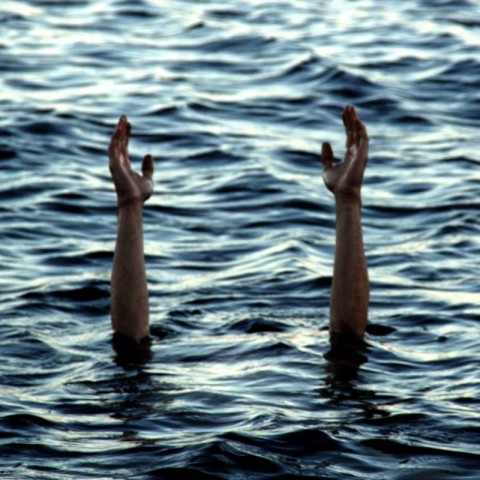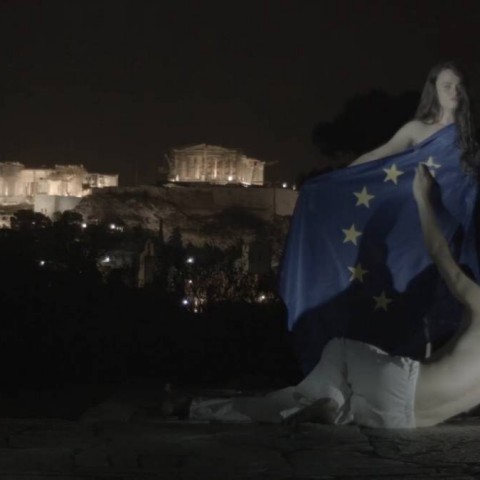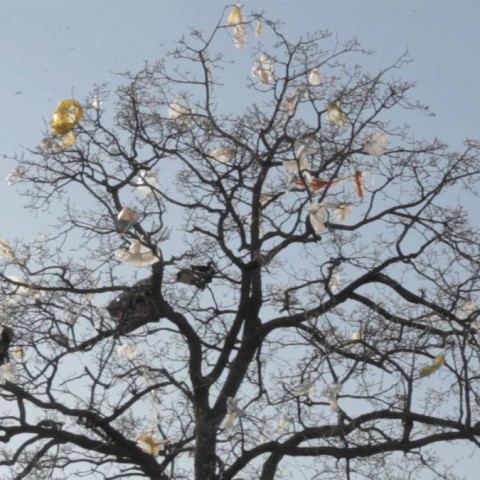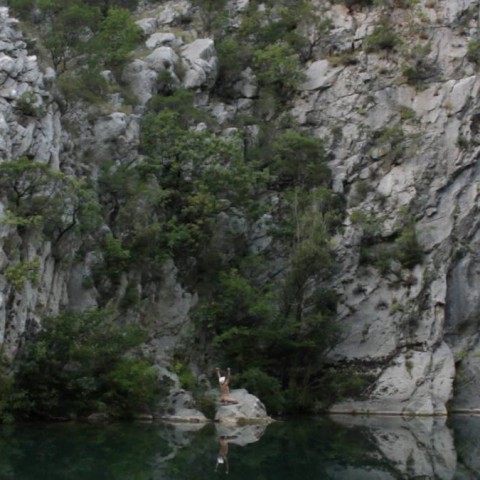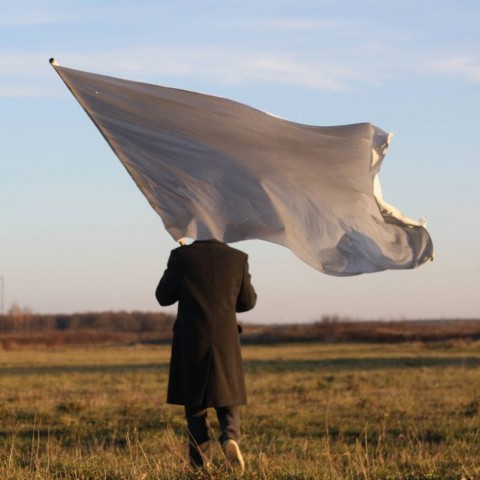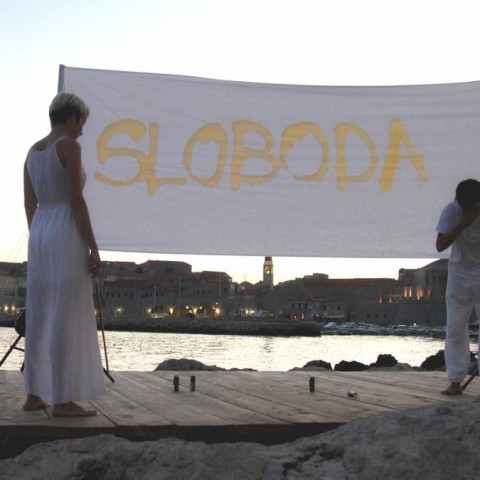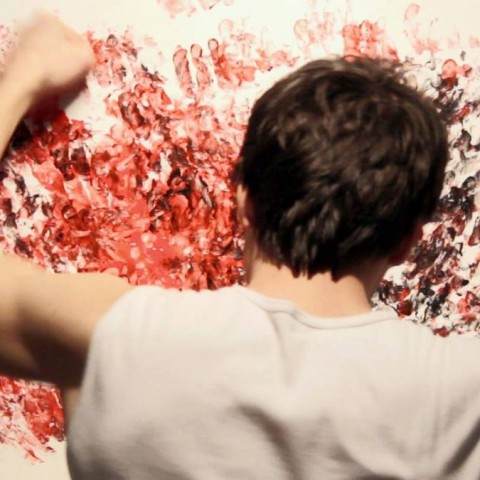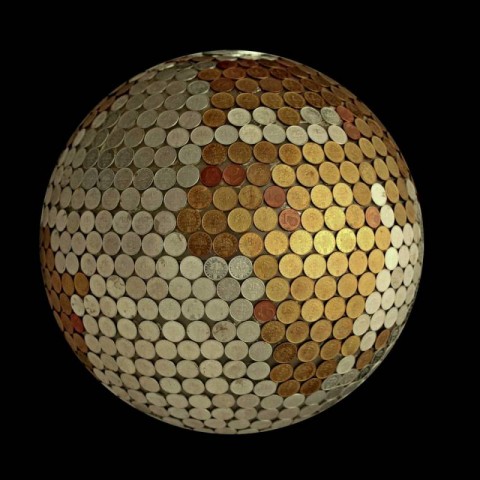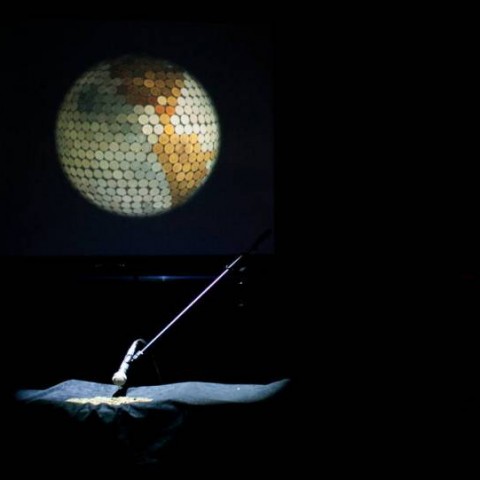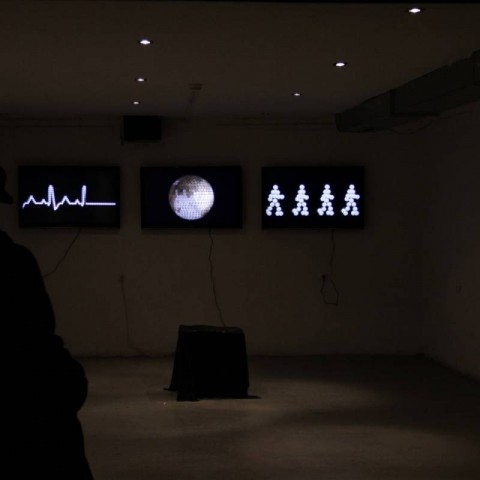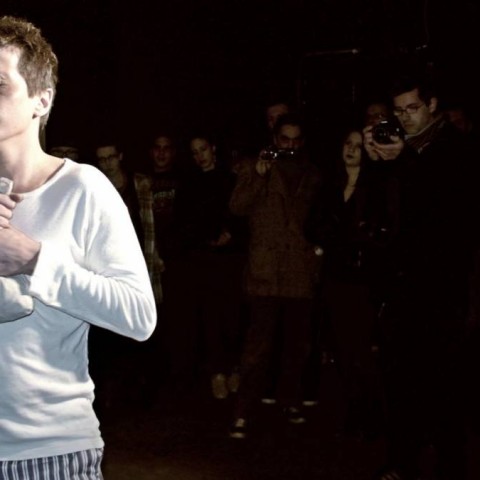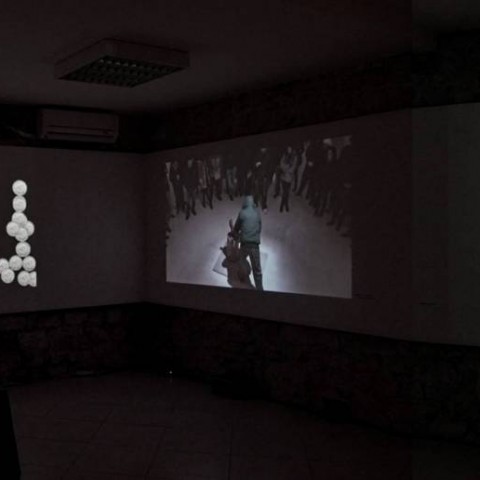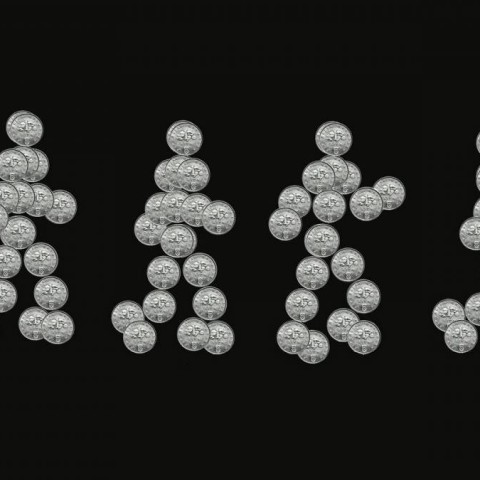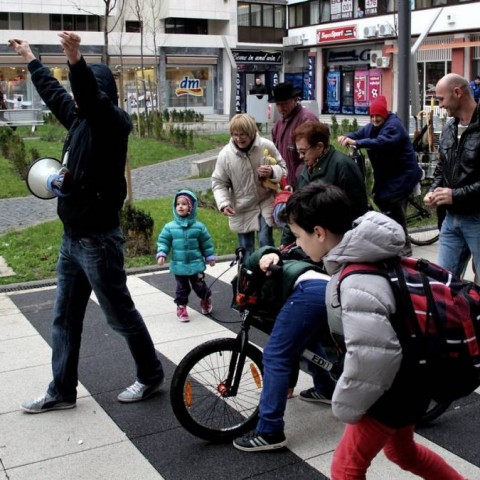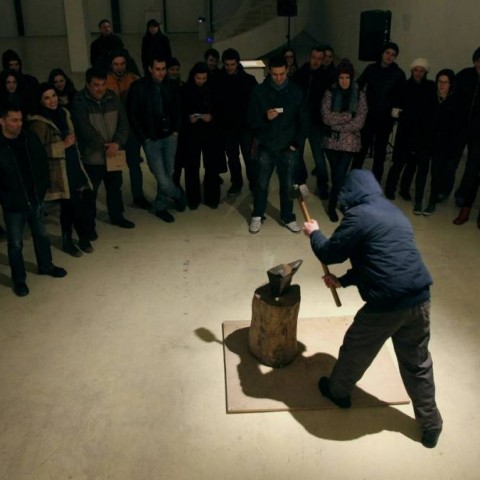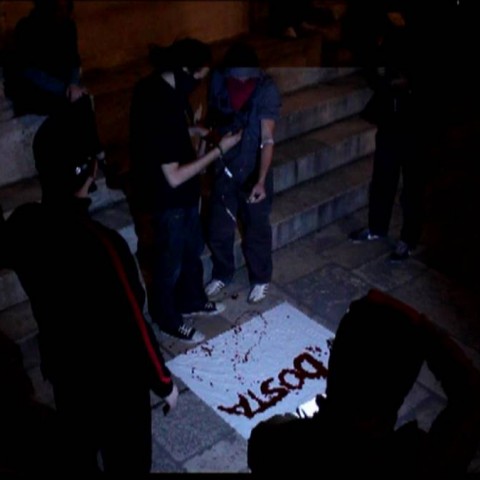Gildo Bavčević
Gildo Bavčević is already known to the Croatian artistic public because with his socially engaged performances and video work he is placed in the true focus of artistic, but also social happenstances. I wouldn't call Bavčević an activist, albeit he will claim he is also that, because in his work and behavior one can't find a minimal dose of aggression that is immanent to the activists, yet I would view him as the engaged artist who calls for reflection by his artworks, instead of calling for the direct rebellion and revolution. The subject he is primary interesting is the phenomenon of money, as a source and cause of the majority of evil and injustices which abound in our world. The interest to the global problem, of course, perceived from the Croatian discourse, is what also differentiate him from the regular domestic activists, because his story rises above local and engulfs the issues that completely belong to the today's grim global reality. Bavčević isn't dealing with diagnosis and causes, but he criticizes secondary manifestations that are caused by this monetary sickness, or he problematizes dominant value forms of the modern society.
Performance ''Fall oh force and injustice'' is conducted with the tone of the known revolutionary reveille related to the antifascist struggle and socialistic revolution during the World War 2. Except for that impressionable revolutionary song, that is calling for a then sought of fall of imperialism, the visual component of the performance (Bavčević with the megaphone, that transmitting aforementioned song, tied across the torso, with the raised hands, is marching through city streets and from the clenched fists he is gradually sliding out the coins) is association to the known photography of the folk hero Stjepan Filipović, hanged by the German army on the 22.05.1942. in Valjevo. Famous photography was shot the moment before Filipović's execution, when he, already with the noose around his neck, with the raised hands and clenched fists shouts in honor to communism and Party, by also calling on the insurgency. That photography has a special significance not only because for its strong message and remembrance of the fights against fascism it was placed in the entrance of United Nations in New York, but also because perhaps the greatest Croatian sculptor, Vojin Bakić, has modeled one of its most significant and important monuments by that photograph.
That monument in Valjevo was during the last two decades damaged on more occasions, and the bust of Filipović in the same town was demolished in 1991. The same year, in the Filipović's birth town, Opuzen, his sculpture (work of Miro Vuco and Stjepan Gračan) was mined. By his performance, Gildo, among other things, is speaking out about these vandalisms from our recent past, when the monuments were demolished in the name of ideology and politics, and the blinded perpetrators usually didn't know why and to whom they were destroying them. The destruction of monuments is the extreme act of barbarism because nowadays we rightfully and with disgust judge the Taliban and ISIL, we don't see, or don't want to see, what happening, and what happened, in our own yard. Idolatry was cursed by Jehovah itself on the Holy mountain of Sinai and is it ideologically-political or solely material provenance is completely irrelevant. Gildo Bavčević is speaking about it in this, balanced to meticulousness and multi-layered, performance, but the performance only begins with the authors walk, transmittal of music and release of coins. Namely, that money released on street would be collected gradually by random passers-by that were there at the time of performance. By crouching and taking the coins from the streets they reveal their miserably material state and also bow down to the money as only recognized authority because of which they will erase their pride and minimum of self-respect.
I would return once again to Stjepan Filipović. The legend says that during his captivity the certain German mayor named Paul questioned him why he became the communist, on which Filipović answered that he would have become one also if were setting up the lightning rods on chimneys for 10 dinars daily, as he was doing. Therefore, the money is the mover of everything. The ideology isn’t there because of the idea, but because of the money that is promised to its followers, that was and continued to be the characteristic of all world revolutions. Gildo is aware that fact and that is why his artistic language is, different from the expression by action and agitation. Although we are inclined to call this term the actual artistic language, I think that the direct agitation by default doesn't belong to the domain of art, because artistic discourse was to upgrade, warn ad comment, and that's just what Gildo Bavčević is doing with his artistic manifestations.
The artist is dedicating to the theme of money the whole series of performances and videos such as the travelling performance Profit versus wellbeing, where he, with the hood covering his head, is gradually destroying the coin to un-recognizability with a sledgehammer, reducing it to the amorphous piece of metal by which he clearly leaves the message what money truly is. By performing this performance in various countries he was always using the domestic coin, and this performance represents a certain work-in-progress since Gildo wants to use it still as a sort of warning and the personal showdown with monetary politics. This series of performances in which the author problematizes money, or it's social, economic, and political dictate, is not only impressive for its clear message that is disseminated by artist, but also for its strength of implementation. Gildo takes in the wholesome of himself in every performance and suggestively witnesses that he completely stands behind the great symbolically-metaphorically designed narrative connotation.
It is similar with the interactiveness since Gildo doesn't agitate and doesn't look for the participation of others, he henceforth simply forces the people with this suggestive performance to join him, often and unconsciously, and thus become an integral part of the artistic act. The video and three video performances are exhibited on this, his award independent exhibition in Zagreb, not problematizing the money with the discourse that is characteristical to the afore-described artist's activities. Gildo has brought the field of interest in the monetary issue on the higher level, where financial power seemingly inconspicuously governs the human and natural resources. The exhibited artworks are telling about the violated relationship between mankind and nature, or about nature's gradual withering, as well as the withering out of the European Union's purport. Although those two topics don't have any connection, that which is holding them together firmly is, of course, the money. Financial power is concentrated in the hands of the corporations that are governing the present world and with its help they are overcrossing any ideological and political bounds. To the arrogant moral freaks that are leading those corporations, it is not enough to control the European and world economy by manipulating finances and controlling the political courses, they want to make the completely subservient resource out of nature.
On the stone that springs out of water surface surrounded by high rocks, Gildo hits his head mechanically on it, while simultaneously disrupts the sounds of nature, but also accentuates them. The moves he does are uniform as well as the rhythm which they produce and author hence becomes the certain machine, the robot that does exclusively one activity. Although he is naked, Gildo protects his head with the plastic helmet that is nowadays used for work protection, wherewith he is unmistakably placing the activity in present time, the present that makes the obedient machines from men, and it also wants to do with nature. This author's performance isn't only the warning to the people about the place and in which environment they live, but it is primary a certain homage to nature or the warning that we should certainly fear the modern courses of civilization. This artist's act is basically a ritual, totemic bowing down and rudimental ceremony, the kind the people conducted when they were symbiosis with nature, which is increasingly rare in the world of today.
Next video, ironically named In cooperation with nature, shows that the warning wasn't useful. The wind cradles the branches on the large three, but instead of leaves, the plastic bags are blinking everywhere, that was carried here from the nearby junkyard by the same wind. Plastic bags are also found in the hands of the streams of refugees that are unstoppably moving to the countries of the European Union, primary Germany. In Greece, the southernmost country of Union, the veritable refugee drama is happening these days, and it oneself has become the shield of particular European interests because of which they need to break their humane principles. During the last year's July, that country was, for its financial problems, blackmailed by Union, and that service is now profusely paid out.
Seeing what is happening, Gildo went to the scene of these misfortunes, Greece, where he, in cooperation with the young actress and performer Tina Keserović, recorded the video artwork Europe sleeps, in which the woman figure, as allegory of Europe, painfully and with stutter, slowly as a lullaby, sings Beethoven's Ode to Joy in the original, German, version. In the front of her naked body is the flag of Union, and artist, sitting half-naked, is covering flag's yellow stars with the blue color until they disappear and merge with the background. The video was shot at night, on some hill in Athens from which one can clearly see, lit by red light, Parthenon, and Acropolis – the symbols of the birth of European civilization. The red color dominates the last artwork of exhibition, named The Waking of Europe. Gildo, now in the red costume of superhero, in front of the equally colored flag of European Union, covers the body of a woman clothed in the colors of German flag with the red color. Standing on the white platform, woman unwillingly is shouting the verses of the song Bloody Red Flag, the German variation of popular Italian song Bandiera Rossa. Simultaneously, Gildo is almost hitting her with the hands sodden with red color but afterward, he daubs her with the healing and protective moves, until the woman, exhausted and completely covered with red color, falls on the platform.
This performance symbolizes the tacit leadership takeover of European Union by Germany, as well as the leadership role of its chancellor Angela Merkel in the actual refugee crisis. Performance is, of course intentionally, conducted in the German town of Jena, where the official black-red-golden flag of Germany was presented for the first time in 1919, and which the Nazis replaced in 1933. with the red color with the applied swastika. Nowadays in Jena, as in most of the cities in the former East Germany, the Nazi movement again grows and swells and the burning of refugee asylums and demonstrations against the foreigners are the everyday occurrence. Is this Bavčević's performance, in which the red color dominates, is calling for setting up Europe on the more humane principle of the Marx-Engels provenance, or it is expressing the fear from the possibility of the establishment of Fourth Reich? The answer is not simple, much as the future of Union is not certain. The refugee crisis is a great test primary to the humanitarian values that are built into the European Union's constitution, but also in every civilized country, but would the human values, for which Gildo Bavčević completely, truthfully and sacrificially stands for, really win, or the battle will be won by the dirty courses of money, on which consequences the artist permanently and systematically warns about, we will see in the near future.
Mladen Lučić
Biography
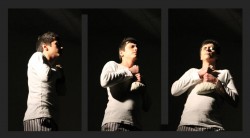
Gildo Bačević
(Split, 1979) is a multimedia artist (performance, video, film, artistic actions, multimedia installations, audio projects, sound recording and design). He has created many performances, video performances, video installations, short films, as well as the sound in three feature-length films. In addition to the presentation of his works in his solo shows, he has participated in a large number of group exhibitions and festivals in Croatia and abroad. He has won a prize at the 39th Split Salon exhibition of contemporary art (Splitski Salon) for his video performance Plastic Man Machine and first prize at 46th Croatian Film Festival (Revija hrvatskog filmskog stvaralaštva) for his documentary Mreža solidarnosti (Solidarity Network), which was his graduate thesis in 2013 with which he obtained his MA in Film and Media Production from Split's Art Academy, from which he received the title of assistant professor. He is a member of both the Croatian Freelance Artist Association and Split's Croatian Visual Artist Association. He lives and works in Split.
video arhiv: https://vimeo.com/gildo
Acknowledgments
- 2015 AWARD 39. SPLIT SALON for video performance Plastic Man Machine
- 2014 First prize at 46th Croatian Film Festival (Revija hrvatskog filmskog stvaralaštva) for short documentary
Solo exhibitions
- 2016. , Kranjčar Gallery, Zagreb, AWARD 39. SPLIT SALON
- 2015. Salon Galic, Split, (DE) FORMATIONS
- 2013. NMG @ Practice, Split, SMALL CHANGE
- 2012. Gallery K.U.N.S. Rijeka, SMALL CHANGE
- 2012. Gallery Zadart, Zadar, SMALL CHANGE
Group exhibitions
- 2016. The European biennial of contemporary art, Zurich (Switzerland), • Manifesta 11: What people do for money
- 2016. Emil Filla Gallery, Ústí nad Labem (Czech Republic), • Please Empty Your Wallets
- 2016. Kunsthof Jena (Germany), RED EU / GERMANY
- 2016. Gallery of Contemporary Art CHARLAMA, Skenderija Sarajevo (Bosnia and Herzegovina), THE CREATOR'S,
- 2016. City gallery, Labin (special programme), • Industrial Art Biennal: Utopia = reality
- 2015. Croatian Visual Artist Association, Split, 39th SPLIT SALON
- 2015. City gallery, Labin, East of Eden
- 2015. Pino Pascali Foundation, Poligano a Mare, Bari (Italy), • COEXISTANCE FOR A NEW ADRIATIC KOINE
- 2015. Varaždin, • 14th Days of Performances
- 2014. Museum of Fine Arts, Osijek, • 24th Slavonian Biennail
- 2014. Pyramida, Tirana (Albania), • COEXISTANCE FOR A NEW ADRIATIC KOINE
- 2014. Gallery Kazamat , Osijek, • Glimpses of Light. To Julije
- 2014. Multimedial center, Museum of Modern and Contemporary Art, Rijeka, Days of Performance of MMC-a
